SYSTEMATIC PALEONTOLOGY
Type species: Grzybowskia multifida Bieda 1950
Grzybowskia jasoni sp. nov.
not Heterostegina reticulata Rütimeyer 1850;
Jambor-Kness 1988, pl. 40.
Grzybowskia reticulata (Rütimeyer); Banner and
Hodgkinson, 1991, p. 272.
not
Heterostegina reticulata Rütimeyer; van der Vlerk 1929, p. 16, figs. 7 and 26.
not
Heterostegina saipanensis Cole; Ludbrook 1965, p. 288, 291, 293, pl. 22, figs. 4 and 6.
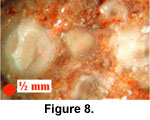 Type specimen: Figure
8 herein. Paratypes in
Figure 9, Figure 10, Figure
11, Figure 12, Figure 13,
Figure 14, and Figure
15. The sample containing the
holotype, and samples and thin sections shown as paratypes, and other paratypic material is stored at the GRDC Museum in
Bandung.
Type specimen: Figure
8 herein. Paratypes in
Figure 9, Figure 10, Figure
11, Figure 12, Figure 13,
Figure 14, and Figure
15. The sample containing the
holotype, and samples and thin sections shown as paratypes, and other paratypic material is stored at the GRDC Museum in
Bandung.
Type location: Flying Fish Cove, Christmas Island. Limestone by the road into the cove, below basalt, mostly of light yellow
colour, GPS location 105.666680°E, 10.429940°S (estimated accuracy ability).
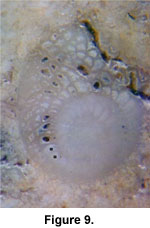 Derivation of name: At the request of the collector of these samples, John
Jaworski, after Jason Jaworski.
Derivation of name: At the request of the collector of these samples, John
Jaworski, after Jason Jaworski.
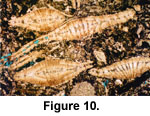 Description: Test free, calcitic, planispiral,
lenticular, bilaterally symmetrical and involute, with canaliculated periphery. Rapidly expanding whorls, especially in late adult phase, which ultimately produces a thin gerontic flange. Test remains involute throughout (not
maturo-evolute). Alar prolongations are well developed and present throughout, although reduced in gerontic stage. The overall size for adult tests is around three to four mm for the more common A forms, with such a test comprising about four whorls. Axial thickness is about 0.8 to 1.0 mm. The microspheric B forms are only slightly larger than the A generation, the few found being 4 to 5 mm with protoconch diameters between 20 and 30
Description: Test free, calcitic, planispiral,
lenticular, bilaterally symmetrical and involute, with canaliculated periphery. Rapidly expanding whorls, especially in late adult phase, which ultimately produces a thin gerontic flange. Test remains involute throughout (not
maturo-evolute). Alar prolongations are well developed and present throughout, although reduced in gerontic stage. The overall size for adult tests is around three to four mm for the more common A forms, with such a test comprising about four whorls. Axial thickness is about 0.8 to 1.0 mm. The microspheric B forms are only slightly larger than the A generation, the few found being 4 to 5 mm with protoconch diameters between 20 and 30
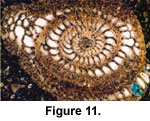 The Nummulitic cord and related canal systems are apparently fine and hard to describe in any detail. A typical Nummulitid intercameral foramen, in a median basal position, is present in all growth stages.
The Nummulitic cord and related canal systems are apparently fine and hard to describe in any detail. A typical Nummulitid intercameral foramen, in a median basal position, is present in all growth stages.
In equatorial sections three stages of growth can be recognized. The first stage lasts about one to two whorls and can be compared with an
"operculine" phase in other heterosteginids, although in this involute form is closest to a
Palaeonummulites test, with simple, radial septa becoming backwards-curved outside the alar prolongation. This stage typically has a maximum size of about 1 mm.
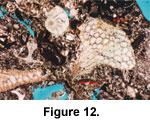 In the adult stage the septa for each instar of growth consist of a radial septum enclosing the alar prolongation, which extends only part way up the outer face of the previous
instar. This septum, therefore, encloses both new alar prolongations and the lower part of a new chamber lumen. More distally are initially two or three arched septa completing the formation of the instar to the distal limits of the test. In each instar the radial septum enclosing the primary chamberlet continues to grow in a slow, regular manner so that the distal limit where it curves back to terminate against the face of the previous instar produces a spiral alignment positioned slightly above the spiral of the previous whorl (e.g.,
Figure 8).
In the adult stage the septa for each instar of growth consist of a radial septum enclosing the alar prolongation, which extends only part way up the outer face of the previous
instar. This septum, therefore, encloses both new alar prolongations and the lower part of a new chamber lumen. More distally are initially two or three arched septa completing the formation of the instar to the distal limits of the test. In each instar the radial septum enclosing the primary chamberlet continues to grow in a slow, regular manner so that the distal limit where it curves back to terminate against the face of the previous instar produces a spiral alignment positioned slightly above the spiral of the previous whorl (e.g.,
Figure 8). 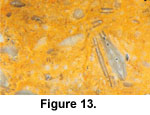 The few small chamberlets that extend to the test periphery are irregular in size and shape. The adult stage grades into a gerontic stage but at the transition the size of the test is typically 1.8 mm and three whorls.
The few small chamberlets that extend to the test periphery are irregular in size and shape. The adult stage grades into a gerontic stage but at the transition the size of the test is typically 1.8 mm and three whorls.
The transition from adult to gerontic stages sees a multiplication of the number of small distal chamberlets in the median plane of the test. This increase in the number of rather irregular chamberlets is accompanied by a necessary increase in the spiral height. At the same time, in axial section, the lateral walls can be seen to become thinner than in previous stages
(Figure 9). The primary chamberlet maintains a fairly regular size and is still dominantly radial, whereas the smaller, more distal chamberlets for the same instar are aligned at a very high angle back from the radial. The gerontic marginal flange is therefore a reticulate fan of arched
chamberlets, with the common face of each instar now facing far more outwards, and not in the direction of the
spial. What happens to the canal system derived from the marginal cord in this gerontic stage has not been determined.
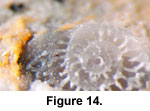 Remarks: This form is placed in the genus Grzybowskia because it shares the distinct morphology of the type species,
G. multifeda Bieda. In particular each adult instar consists of a primary
chamberlet, dominantly radial and including both the alar prolongations. The same instar of growth also produces multiple small chamberlets in a strongly backwards-curved alignment, each with rather irregularly arched chamberlet walls. This geometry produces the bifurcations and consequent polygonal chamberlets that distinguish the genus. In the words of
Bieda (1950) "Dans la partie de la spire correspondante a l' état adulte, les bifurcations des cloisons forment des loges secondaires, d'une forme variable." This contrasts with other members of the Heterostegininae which have a dominant outer septa, clearly defining the
instar, and perpendicular internal septula separating the sub-rectangular
chamberlets.
Remarks: This form is placed in the genus Grzybowskia because it shares the distinct morphology of the type species,
G. multifeda Bieda. In particular each adult instar consists of a primary
chamberlet, dominantly radial and including both the alar prolongations. The same instar of growth also produces multiple small chamberlets in a strongly backwards-curved alignment, each with rather irregularly arched chamberlet walls. This geometry produces the bifurcations and consequent polygonal chamberlets that distinguish the genus. In the words of
Bieda (1950) "Dans la partie de la spire correspondante a l' état adulte, les bifurcations des cloisons forment des loges secondaires, d'une forme variable." This contrasts with other members of the Heterostegininae which have a dominant outer septa, clearly defining the
instar, and perpendicular internal septula separating the sub-rectangular
chamberlets.
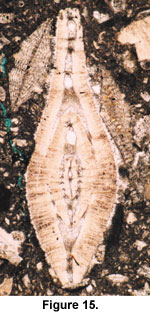 The new species illustrated here differs from G. multifeda in the form the chamberlets take, and the stage of growth at which they appear. In pl. 3 fig. 1 of
Bieda's
(1950) original (reproduced as pl. 808
fig 10 in Loeblich and Tappan 1987), as well as Bieda's pl. 3 figs. 2, 3, 4, 6 and pl. 4 fig. 2,
G. multifeda shows a preferred alignment of the small chamberlets that implies the outer, more distal one precedes the formation on the next inner one
(in other words, the outermost wall is curved, and the next chamberlet wall abuts upon this pre-formed
curve). Such a stacking pattern is not seen in the new species described here. In addition the formation of such secondary chamberlets begins in
G. multifeda almost immediately after the embryonic stage. There may be about
two "operculine" or undivided chambers after the embryont, but not lasting more than a third of a whorl. This strongly contrasts with the ontogeny described above, especially the juvenile
"operculine" stage lasting about two whorls.
The new species illustrated here differs from G. multifeda in the form the chamberlets take, and the stage of growth at which they appear. In pl. 3 fig. 1 of
Bieda's
(1950) original (reproduced as pl. 808
fig 10 in Loeblich and Tappan 1987), as well as Bieda's pl. 3 figs. 2, 3, 4, 6 and pl. 4 fig. 2,
G. multifeda shows a preferred alignment of the small chamberlets that implies the outer, more distal one precedes the formation on the next inner one
(in other words, the outermost wall is curved, and the next chamberlet wall abuts upon this pre-formed
curve). Such a stacking pattern is not seen in the new species described here. In addition the formation of such secondary chamberlets begins in
G. multifeda almost immediately after the embryonic stage. There may be about
two "operculine" or undivided chambers after the embryont, but not lasting more than a third of a whorl. This strongly contrasts with the ontogeny described above, especially the juvenile
"operculine" stage lasting about two whorls.
The species illustrated here is the same as that illustrated by
Ludbrook (1965, pl. 22, figs. 4 and 6, from the same location in
Flying Fish Cove), but is not conspecific with
H. saipanensis Cole, which has sub-rectangular chamberlets appearing immediately after the embryonic stages.
The status of Grzybowskia has a irregular history due to the original definition of Bieda noting both the distinctive non-rectangular chamberlets (and absence of a primary outer septa) and also the invalid status of
Heterosteginella Silvestri for involute heterostegines. Thus later workers not only applied the name
Grzybowskia to forms with polygonal chamberlets, but some also applied the name to specimens with rectangular chamberlets that were
involute. However as pointed out by Banner and Hodgkinson
(1991), in discussing a broad definition of
Grzybowskia and related forms, "These polygonal chamberlets are restricted to the Late Eocene. No species of other ages are known to possess them. Similarly, the distinctively broad chamberlets of the later whorls of
Anastegina also characterize the Late Eocene; nothing like them is known from rocks of any other age. These features alone would justify the taxonomic recognition of these genera as phylogenetically and biostratigraphically distinct, each allows recognition of samples of Late Eocene age. To confuse these genera with the long ranging
Heterostegina (Vlerkina), just because all are wholly involute makes no taxonomic or biostratigraphic sense."
Therefore, it can be seen that the heterosteginids with polygonal-irregular chamberlets are a biostratigraphically significant group and the selection of this character to define a genus rather than species appears logical. This degree of identity is supported by the data presented here, which indicates this taxon occupies a specific palaeogeographic setting. The other heterostegines do not appear to have such a restrictive
palaeogeography.
The Late Eocene age implied for the Christmas Island limestones (and later Late Eocene implied from text figure 1 of
Banner and Hodgkinson 1991) is not yet proven.
Banner and Hodgkinson
(1991), citing Herb (1978) and
Jambor-Kness (1988), referred the species
H. reticulata Rütimeyer to the genus Grzybowskia. Noting "the pentagonal or hexagonal chamberlets of the early whorls of
G. retculata (Rütimeyer) ... have been well illustrated by Jambor-Kness
1988 pl. 40)." This species has been recorded in Southeast Asia by van der Vlerk
(1929), from the Early Oligocene, Tertiary C, of Northeast Borneo. The illustrations of van der Vlerk clearly show that this
taxon is not the species described here, with rectangular chamberlets from a very early ontogentic stage. The original
H. reticulata Rütimeyer was found in the Late Eocene, as are the specimens of
Jambor-Kness, but again neither the original sketch of Rütimeyer nor the new illustrations of Jambor-Kness show a form like the new species described here.
Finally a note is made regarding a possible morphological link between
G. jasoni and Operculina eniwetokensis Cole, from the Late Eocene of
Eniwetok, Guam and other Pacific islands. Operculina eniwetokensis has a similar slightly flattened,
lenticular, involute test and rate of growth comparable to the juvenile of G. jasoni, although the protoconch is half the size.
Operculina eniwetokensis has a gerontic stage, after two or three whorls, in which a primary chamberlet develops reaching only part way up the apertural face of the previous chamber, together with a few broad and irreguar additional chamberlets (see especially
Cole 1957, pl. 232 fig. 23, and
Cole 1963, pl. 5 fig. 12). The fragmented, and poorly preserved, nature of the gerontic stage in Cole's figures suggests it is thinner walled, like the gerontic stage of
G. jasoni. Following the principles of nepionic acceleration seen in many other larger
foraminifera, O. eniwetokensis could be considered a potential candidate as ancestor to
G. jasoni. The increase in protoconch size, and concomitant reduction of the juvenile while extending the adult and gerontic stages is a typical ontogenetic pattern seen in phylogenetic reconstructions where better sequences of material are available (e.g.,
Cycloclypeus, Lepidocyclina, Miogypsina). However, the scarcity of the
Operculina-Grzybowskia forms, and the short period of time within the Late Eocene suggests it will be hard to find "missing links" to validate this hypothesis. Also it must be noted that
O. eniwetokensis occurs in the low latitude fauna, whereas this paper has correlated
G. jasoni with higher latitude assemblages.

 Type specimen: Figure
8 herein. Paratypes in
Figure 9, Figure 10, Figure
11, Figure 12, Figure 13,
Figure 14, and Figure
15. The sample containing the
holotype, and samples and thin sections shown as paratypes, and other paratypic material is stored at the GRDC Museum in
Bandung.
Type specimen: Figure
8 herein. Paratypes in
Figure 9, Figure 10, Figure
11, Figure 12, Figure 13,
Figure 14, and Figure
15. The sample containing the
holotype, and samples and thin sections shown as paratypes, and other paratypic material is stored at the GRDC Museum in
Bandung.






